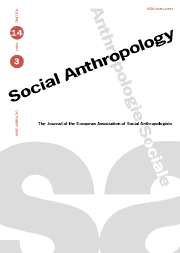Bequeathing and quest. Processing personal identification papers in bureaucratic spaces (Cuzco, Peru)
Published online by Cambridge University Press: 09 April 2001
Abstract
This article is about personal identity documents and bureaucratic space in Peru. In applying for and renewing a range of personal documentation, individuals trace and re-trace steps through the streets and official buildings of Cuzco in Peru's southern highlands. This movement is highly visible in an unusual urban setting characterised by complex overlays of Incan, colonial, republican and contemporary administrative spaces. While the state constructs personal identification in the process, bodily lessons of citizenship are conveyed through spatial interaction with bureaucratic room. Active participation and varying degrees of acquiescence in these documentary peregrinations visibly legitimise the state presence and dominion on the urban scene. Thus, citizens are created through the sequence of bureaucratic identification on the one hand, and on the other, the state is made evident through the dynamic movement of people through the identification process. Bodily movement both integrates bureaucratic space and is integrated by such places.
- Type
- Research Article
- Information
- Copyright
- © 2001 European Association of Social Anthropologists
Footnotes
- 3
- Cited by


